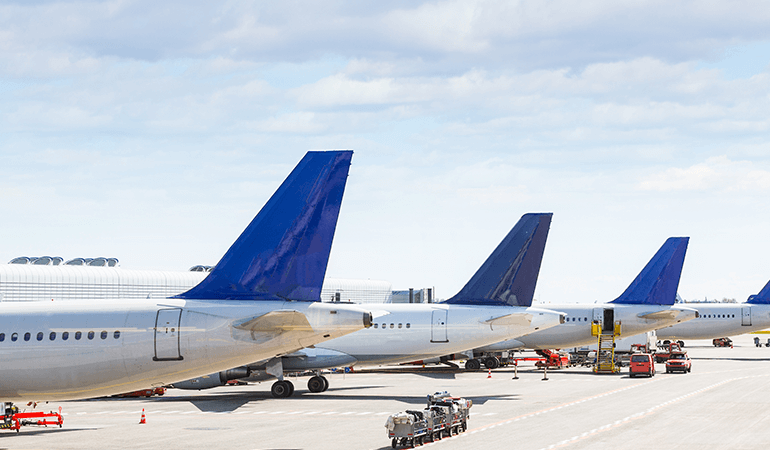The global aviation market is feeling a heavy burden from the COVID-19 outbreak. Here’s an outlook of what’s to come.
What are your prognoses?
Coronavirus and Aviation: What to Expect
It is unlikely that you have not heard about the Novel Coronavirus, or COVID-19. In fact, it is probably the only thing on your news feed since it has been recently labeled a global pandemic. Unfortunately, the global aviation market is feeling a heavy burden from the COVID-19 outbreak, since the universal guidance is to restrict travel and refrain from confined areas, and to curtail travel. So basically, every single aspect of air travel is a risk of spreading the virus. We are going to take a look.
Immediate Financial & Market Implications of the Coronavirus
Before we dive into the aviation-specifics of this pandemic, we need to gain an overall bird’s-eye view of the market disruption of COVID-19.
- Monday, March 16th, showed a huge toll on stock markets with the S&P 500 falling 12%, and NASDAQ was hit with it’s largest downturn in history.
- The airline industry is poised to request anywhere between $50B and $60B in direct assistance from the U.S. government.
- All world governments are either urging or have restricted travel entirely until further notice.
Most industries are looking at dire circumstances due to the outbreak, and it is affecting the entire market. With many cities and municipalities forbidding public gatherings larger than ten people, and shuttering bars and restaurants altogether, the economy of small business hangs precariously in the balance.
What the Carriers Are Saying about COVID-19
There does not seem to be any shortage of opinions on the pandemic, but answers are a lot thinner. All of the major airlines have issued guidance on their respective responses, but they are largely in a free-fall right now.
- On March 10th, Delta had reduced flights by 15% and had imposed a hiring freeze, but with the rate of change right now, that figure has probably adjusted considerably since then. Delta stocks have plummeted, down nearly 30% in the past five days.
- United Airlines (UAL) has cut international flights by 85%, with domestic flights being reduced by 42%. This sums up a combined 60% reduction in flights across the board. While they currently do not plan to reduce any more flights, everything is in flux right now and subject to immediate change. United’s stocks have taken a significant hit, dropping nearly 40% in the last week.
- American Airlines (AAL) is cutting international long-haul flights by 75% as of March 16th with a target end date of May 6th. They will continue to operate one flight from D/FW to London daily, one from Miami to London daily, and three weekly flights from D/FW to Tokyo. Their most recent value on the NASDAQ exchange is down about 29% over the last week.
- Southwest Airlines (LUV) is cutting 20% of their flights across the board from April 14th through June 5th, although it is likely these dates will become a moving target since there are so many unknowns. Southwest’s stocks have dropped almost 23% since opening.
European airlines have not been effected to nearly the same level as the North American airlines, although they are also consistently down across the board:
- Ryanair Holding (LON: RYA) is down just about 9% in the past 24 hours.
- easyJet (LON: EZJ) is down nearly 17%, a significant drop although nowhere near that of any of the major U.S. airlines.
- Deutsche Lufthansa (ETR: LHA) is down about 8.5%, and has shown peaks during this timeframe.
It is important to keep in consideration that airlines in Europe have been dealing with COVID-19 for quite a while longer than their North American counterparts, so we can expect some course correction and leveling out in American airlines in the next few days and weeks.
What the Regulators are Saying about COVID-19
Federal Aviation Administration (U.S.)
The FAA has been updating it’s position on the COVID-19 almost daily to try and keep ahead of the ever-changing events. The most recent development has been the confirmed infection of a number of air traffic controllers spread out all over the country, with confirmed cases in Indianapolis, Las Vegas, JFK in New York, and most recently, Midway in Chicago. Midway ended up cancelling some 240 flights due to the recent diagnosis, and prime example of the high risk and sensitivity of the aviation market altogether.
While the FAA can pass along information and best practices from other agencies, as a regulatory body there is very little that COVID-19 is actually affecting in aviation operations itself; it is the second- and third-order effects which are mounting.
International Civil Aviation Organization (ICAO)
ICAO, another arm of the United Nations, has provided an invaluable matrix on a dedicated webpage for COVID-19 response based on regulatory framework, and implementation of responses.
Generally speaking, they offer a similar perspective as everyone else has: don’t travel unless you absolutely must. Airlines must be particularly strict about fully cleaning and disinfecting their aircraft. Do not travel to and from the globe’s COVID-19 hot spots (Italy, China, Iran, etc). There are only so many ways that they can keep saying the same thing. However, staying at home does not bode well for an industry which has no purpose other than moving people.
What the Manufacturers are Saying (and doing) about the Corona crisis
Boeing
After a year of their prize 737 MAX being grounded, Boeing is particularly vulnerable to any further disruptions in the aviation market, and it is fair to say that the COVID-19 pandemic goes far beyond the level of ‘disruption’. Not to mention the KC-46A fiasco and falling out with the U.S. Air Force, and you see a company which could easily be in a crisis of its own.
Boeing’s stock prices are consistent with most of the american airliners (who they largely supply) in the significant pounding they have taken in stock values. A month ago, in the end of February, they were around $340; as of today (March 20th), they are at $95. This is largely why we see Boeing standing at the front of the line for stimulus money from the federal government, although it is questionable as to how much COVID-19 really has had to do with their financial woes.
Airbus
Boeing’s prime competitor, Airbus, is not on as shaky of ground as Boeing to be honest. They have not had similar woes at the KC-46 or MAX issues, so there were no “pre-existing conditions” associated with Boeing’s struggles. Accordingly, Airbus’s value drop has been considerably less jarring than Boeing’s.
While many American companies are still in the process of shutting down, much of Europe has already been in the middle of COVID-19 for quite some time and are looking towards recovery. Airbus is eyeing reopening, although at a limited capacity to standard. But this is really good news for a market which is in the midst of real devastation.
The Future of Aviation
So what exactly does the future hold for aviation? It’s really impossible to have any answers of any solvenace at all right now because the entire world is in turmoil. Entire countries remain on total lockdown, and these are modern, First World nations!
Delta has already stated that it will come out of the COVID-19 era, a significantly smaller airline. What that means is not entirely clear but it is obvious to even the most novice onlooker that Delta is not going to be alone.
We have to face the reality that aviation as we know it is not going to be the same. It is entirely likely that some of the airlines are going to go under. Those which do not dissolve entirely are going to be parsed up and sold off to investors who will trim the fat and streamline said airlines into profitable ventures.
There is also likely to be a general shift toward private or chartered business air travel. It appears that the COVID outbreak is a pandemic which will be measured in terms of months, not days and weeks. Executives who would have flown commercial in the past may turn to charter aircraft to minimize exposure to the virus.
Market elements of aviation support, including GSE manufacturers, are going to have to ride out the ebbs and flows of these turbulent waters in the future; their products are tied directly to jet operations. Fortune is with those forward thinkers who design and market to more than just one area because they will likely make up for lags in the operational area of the market by marketing to other areas. In a time where social distancing is a premium, utilizing robotics and automated guidance makes great sense, especially when it reduces the number of employees necessary on site.
Conclusion to the Coronavirus’ effect on aviation
We really have no idea how bad this is going to be for the aviation community, but we are seeing strong indicators of it being catastrophic in nature. The aviation markets are the hardest hit in logistics simply due to the fact that international travel and travel in close confines are the antithesis of what needs to be done to contain COVID-19. Look for future updates on this topic as the picture becomes more clear in the ensuing weeks; it would be nice to use the word ‘stabilize’ but that may be an unrealistic outlook. Only time will tell.
Stay updated on the latest news in ground handling and subscribe to our blog now!


Comments